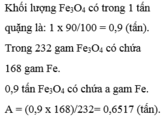Hãy nhập câu hỏi của bạn vào đây, nếu là tài khoản VIP, bạn sẽ được ưu tiên trả lời.

a) mFe2O3= 60%.10=6(tấn)
=> mFe= (112/160).6= 4,2(tấn)
b) nH2O=36/18=2(mol)
=> Số mol nguyên tử trong 2 mol H2O là: 2.2+ 2.1=6(mol)
Tổng số nguyên tử của các nguyên tố trong 36 gam H2O là:
6.6.1023=3,6.1024 (nguyên tử)
Chúc em học tốt!

Đổi 1 tấn = 1000 kg
nFe2O3 = 1000 . 90% : 160 = 5,625 (kmol)
nFe = 5,625 . 3 = 16,875 (kmol)
mFe = 16,875 . 945 (kg)

Bài 1 :
Khối lượng FeS thu được sau phản ứng biết lưu huỳnh dư 1,6 g :
mFe = mFe + mS - mS.dư
= 2,8 + 3,2 - 1,6
= 4,4 (g)

Đặt mA = a (tấn); mB = b (tấn)
Giả sử a + b = 1 (tấn) (1)
\(m_{Fe_2O_3\left(A\right)}=a.60\%=0,6a\left(tấn\right)=6.10^5a\left(g\right)\)
=> \(n_{Fe_2O_3\left(A\right)}=\dfrac{6.10^5a}{160}=3750a\left(mol\right)\Rightarrow n_{Fe\left(A\right)}=7500a\left(mol\right)\)
\(m_{Fe_3O_4\left(B\right)}=b.69,6\%=0,696b\left(tấn\right)=696.10^3b\left(g\right)\)
=> \(n_{Fe_3O_4\left(B\right)}=\dfrac{696.10^3b}{232}=3000b\left(mol\right)\Rightarrow n_{Fe\left(B\right)}=9000b\left(mol\right)\)
\(n_{Fe\left(tổng\right)}=\dfrac{0,48.10^6}{56}=\dfrac{60000}{7}\left(mol\right)\)
=> \(7500a+9000b=\dfrac{60000}{7}\) (2)
(1)(2) => \(a=\dfrac{2}{7}\left(tấn\right);b=\dfrac{5}{7}\left(tấn\right)\)
=> \(\dfrac{a}{b}=\dfrac{2}{5}\)

Đặt mA = a (tấn); mB = b (tấn)
Giả sử a + b = 1 (tấn) (1)
\(m_{Fe_2O_3\left(A\right)}=a.60\%=0,6a\left(tấn\right)=6.10^5a\left(g\right)\)
=> \(n_{Fe_2O_3\left(A\right)}=\dfrac{6.10^5a}{160}=3750a\left(mol\right)\Rightarrow n_{Fe\left(A\right)}=7500a\left(mol\right)\)
\(m_{Fe_3O_4\left(B\right)}=b.69,6\%=0,696b\left(tấn\right)=696.10^3b\left(g\right)\)
=> \(n_{Fe_3O_4\left(B\right)}=\dfrac{696.10^3b}{232}=3000b\left(mol\right)\Rightarrow n_{Fe\left(B\right)}=9000b\left(mol\right)\)
\(n_{Fe\left(tổng\right)}=\dfrac{0,48.10^6}{56}=\dfrac{60000}{7}\left(mol\right)\)
=> \(7500a+9000b=\dfrac{60000}{7}\) (2)
(1)(2) => \(a=\dfrac{2}{7}\left(tấn\right);b=\dfrac{5}{7}\left(tấn\right)\)
=> \(\dfrac{a}{b}=\dfrac{2}{5}\)

a)
$m_{Fe_3O_4} = 100.1000.69,6\% = 69600(kg)$
$n_{Fe_3O_4} = 69600 : 232 = 300(kmol)$
$m_{Fe} = 300.3.56 = 50400(kg)$
b)
$n_{CuSO_4} = \dfrac{4,8}{160} = 0,03(mol)$
Số nguyên tử Cu = Số nguyên tử S = 0,03.6.1023 = 0,18.1023 nguyên tử
Số nguyên tử O = 0,03.4.6.1023 = 0,72.1023 nguyên tử
a) Khối lượng Fe3O4 có trong quặng là: mFe3O4 = 100* 69,6%= 69,6 (tấn)
-> nFe3O4 = m/M = 69,6 / 232= 0,3 (mol)
-> nFe = 3 nFe3O4 = 0,3*3 = 0,9 (mol)
-> mFe = n*M = 0,9* 56= 50,4 (tấn)
vậy trong 100 tấn quặng manhetit chứa 50,4 tấn Fe